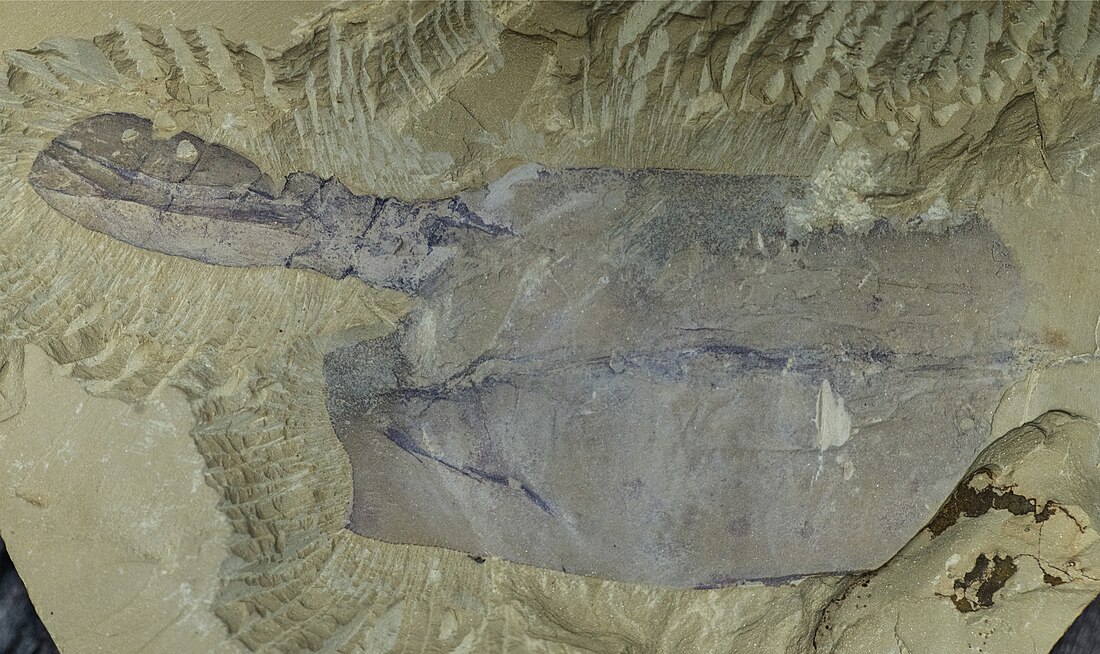Top Qs
Timeline
Chat
Perspective
Vetulicola
Fossil genus of marine animal From Wikipedia, the free encyclopedia
Remove ads
Vetulicola is an extinct genus of marine animal discovered from the Cambrian of China. It is the eponymous member of the enigmatic taxon Vetulicolia, which is of uncertain affinities but may belong to the deuterostomes.[1] The name was derived from Vetulicola cuneata, the first species described by Hou Xian-guang in 1987 from the Lower Cambrian Chiungchussu Formation in Chengjiang, China.[2]
Remove ads
Etymology
Vetulicola is a compound Latin word composed of vetuli, meaning "old," or "ancient," and cola, meaning "inhabitant."[2]
Description
Summarize
Perspective

pharynx and alimentary canal: dashed line; dorsal and ventral food grooves: dotted line; gill slits: pink
The type species, Vetulicola cuneata, as originally described by Hou Xian-guang in 1987, has a body plan similar to those of arthropods and composed of two distinct parts of approximately equal length.[3] The anterior part is rectangular with a carapace-like structure of four rigid cuticular plates, with a large mouth at the front end.[4] The posterior section is slender, strongly cuticularised and placed dorsally. Paired openings connecting the pharynx to the outside run down the sides. These features are interpreted as possible primitive gill slits. Vetulicola cuneata could be up to 9 cm long. The Vetulicola are thought to have been swimmers that were possible filter feeders.[5]
Other Vetulicola species described are Vetulicola rectangulata (Luo and Hu, 1999), V. gantoucunensis (Luo et al., 2005), V. monile (Aldridge et al., 2007), and V. longbaoshanensis (Yang et al., 2010). The mouth openings of all the other species are smaller, and do not protrude as in V. cuneata. All other species, with the stark exception of V. gantoucunensis, are smaller than the type species.
Remove ads
Taxonomy
Vetulicola is the namesake genus of the family Vetulicolidae, which also includes Ooedigera and Beidazoon.[6]
The family has been recovered as a monophyletic clade even in a 2024 analysis that yielded a paraphyletic Vetulicolia and Vetulicolida, although that same analysis found that the sole species of Beidazoon, B. venustrum, is more closely related to V. monile than V. monile is to other members of Vetulicola:[7]
An earlier study in 2014 treated Vetulicola as monophyletic, but was unable to resolve any relationships among vetulicolians as a group:[8]
| Vetulicolia† |
| ||||||||||||||||||||||||||||
Paleobiology

Vetulicola was the host of the symbiotic organism Vermilituus gregarius, which appears to have lived inside Vetulicola's anterior body. Only around 2% of Vetulicola individuals had Vermilituus infestations, but Vermilituus could be very numerous: one Vetulicola specimen had 88 individuals of Vermilituus infesting it. Such large numbers of symbiotic organisms were probably harmful to the host Vetulicola.[5]
Remove ads
References
External links
Wikiwand - on
Seamless Wikipedia browsing. On steroids.
Remove ads

